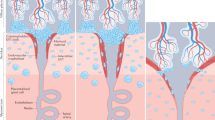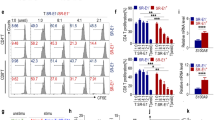Abstract
ALTHOUGH the infant possesses histocompatibility antigens which differ significantly from those of the mother, the foetal allograft manages to survive the period of gestation without being rejected. To explain this apparent paradox of transplantation immunology, Medawar in 1953 advanced several hypotheses1. These included (1) that the uterus may be an immunologically privileged site; (2) that the foetal antigens are weakly expressed; (3) that there may be an anatomical barrier separating the maternal and foetal circulations, and (4) that pregnancy may be accompanied by some reduction in the immunological capacity of the mother. We have attempted to evaluate one aspect of this problem using an in vitro correlate of cellular hypersensitivity to study the immunological response of the mother's lymphocytes to those of her infant. This technique, the macrophage migration inhibition assay2, measures the elaboration of a soluble material, migration inhibitory factor (MIF), from sensitized lymphocytes after stimulation by specific antigen3,4. Previous work with mice has shown that when peritoneal exudate cells from two genetically different strains were mixed together for 24 h their migration was not inhibited, that is, no MIF was generated, unless one strain had been previously sensitized to the other5. In these conditions, the assay appeared to be measuring a cellular immune response indicating prior sensitization. This is in contrast to the response observed in the standard mixed lymphocyte reaction which measures at 5 days the incorporation of 3H-thymidine into lymphocyte DNA. The latter response records an event of primary sensitization between lymphocytes of individuals with different histocompatibility antigens.
This is a preview of subscription content, access via your institution
Access options
Subscribe to this journal
Receive 51 print issues and online access
$199.00 per year
only $3.90 per issue
Buy this article
- Purchase on Springer Link
- Instant access to full article PDF
Prices may be subject to local taxes which are calculated during checkout
Similar content being viewed by others
References
Medawar, P. B., in Symp. Soc. Exp. Biol., No. 7, 320 (1953).
David, J. R., Al-Askari, S., Lawrence, H. S., and Thomas, L., J. Immunol., 93, 264 (1964).
Bloom, B. R., and Bennett, B., Science, 153, 80 (1966).
David, J. R., Proc. US Nat. Acad. Sci., 56, 72 (1966).
Al-Askari, S., David, J. R., Lawrence, H. S., and Thomas, L., Nature, 205, 916 (1965).
Rocklin, R. E., Meyers, O. L., and David, J. R., J. Immunol., 104, 95 (1970).
Anderson, J. M., Lancet, ii, 1077 (1971).
Hellström, K. E., and Hellström, I., Ann. Rev. Microbiol., 24, 373 (1970).
Ceppellini, R., Bonnard, G. D., Coppo, Miggiano, V. C., Pospish, M., Curtoni, E. S., and Pellegrino, M., Transplantation Proc., 3, 58 (1971).
Bartfeld, H., and Atoynatan, T., Nature, 230, 246 (1971).
Phillips, S. M., Carpenter, C. B., and Merrill, J., Fed. Proc., Abstr., 30, 648 (1971).
Desai, R. G., and Creger, W. P., Blood, 2l, 665 (1963).
Brown, E. S., Brit. Med. J., 1, 1000 (1963).
Author information
Authors and Affiliations
Rights and permissions
About this article
Cite this article
ROCKLIN, R., ZUCKERMAN, J., ALPERT, E. et al. Effect of Multiparity on Human Maternal Hypersensitivity to Foetal Antigen. Nature 241, 130–131 (1973). https://doi.org/10.1038/241130a0
Received:
Revised:
Issue Date:
DOI: https://doi.org/10.1038/241130a0
This article is cited by
-
Possible protecting role of maternal immunoglobulins on embryonic development in mammals
Immunogenetics (1977)
Comments
By submitting a comment you agree to abide by our Terms and Community Guidelines. If you find something abusive or that does not comply with our terms or guidelines please flag it as inappropriate.



